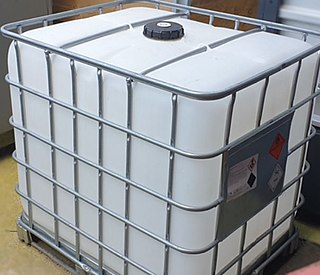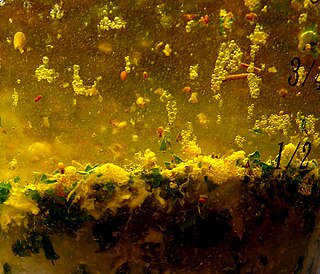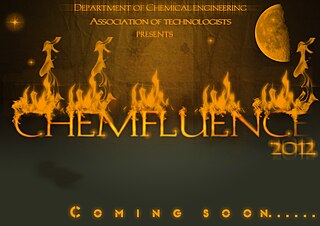
Ethanol is an organic compound. It is an alcohol with the chemical formula C2H6O. Its formula can also be written as CH3−CH2−OH or C2H5OH. Ethanol is a volatile, flammable, colorless liquid with a characteristic wine-like odor and pungent taste. It is a psychoactive recreational drug, and the active ingredient in alcoholic drinks.

Methanol (also called methyl alcohol and wood spirit, amongst other names) is an organic chemical and the simplest aliphatic alcohol, with the formula CH3OH (a methyl group linked to a hydroxyl group, often abbreviated as MeOH). It is a light, volatile, colourless, flammable liquid with a distinctive alcoholic odour similar to that of ethanol (potable alcohol). Methanol acquired the name wood alcohol because it was once produced chiefly by the destructive distillation of wood. Today, methanol is mainly produced industrially by hydrogenation of carbon monoxide.

Biofuel is a fuel that is produced over a short time span from biomass, rather than by the very slow natural processes involved in the formation of fossil fuels, such as oil. Biofuel can be produced from plants or from agricultural, domestic or industrial biowaste. The climate change mitigation potential of biofuel varies considerably, from emission levels comparable to fossil fuels in some scenarios to negative emissions in others. Biofuels are mostly used for transportation, but can also be used for heating and electricity. Biofuels are regarded as a renewable energy source.

Methyl tertiary-butyl ether (MTBE), also known as methyl tert-butyl ether and tert-butyl methyl ether, is an organic compound with a structural formula (CH3)3COCH3. MTBE is a volatile, flammable, and colorless liquid that is sparingly soluble in water. Primarily used as a fuel additive, MTBE is blended into gasoline to increase its octane rating and knock resistance, and reduce unwanted emissions.
Dimethyl ether (DME; also known as methoxymethane) is the organic compound with the formula CH3OCH3, (sometimes ambiguously simplified to C2H6O as it is an isomer of ethanol). The simplest ether, it is a colorless gas that is a useful precursor to other organic compounds and an aerosol propellant that is currently being demonstrated for use in a variety of fuel applications. It is an isomer of ethanol.

Alternative fuel, known as non-conventional and advanced fuels, are any materials or substances that can be used as fuels, other than conventional fuels like; fossil fuels, as well as nuclear materials such as uranium and thorium, as well as artificial radioisotope fuels that are made in nuclear reactors.
Methanol fuel is an alternative biofuel for internal combustion and other engines, either in combination with gasoline or independently. Methanol (CH3OH) is less expensive to produce sustainably than ethanol fuel, although it produces more toxic effects than ethanol and has lower energy density than gasoline. Methanol is safer for the environment than gasoline, it is an anti-freeze, it keeps the engine clean, it has a higher flashpoint in case of fire, and it is the equivalent of super high-octane gasoline in terms of the resulting horsepower. It can readily be used in most modern engines with a simple software setting tweak and occasionally a change in a cheap fuel seal or line. To prevent vapor lock in any possible circumstances due to being a simple, pure fuel, a small percentage of other fuel or certain additives can be included. Methanol (a methyl group linked to a hydroxyl group) may be made from hydrocarbon or renewable resources, in particular natural gas and biomass respectively. It can also be synthesized from CO2 (carbon dioxide) and hydrogen. Methanol fuel is currently used by racing cars in many countries but has not seen widespread use otherwise.

The methanol economy is a suggested future economy in which methanol and dimethyl ether replace fossil fuels as a means of energy storage, ground transportation fuel, and raw material for synthetic hydrocarbons and their products. It offers an alternative to the proposed hydrogen economy or ethanol economy, though these concepts are not exclusive.

Synthetic fuel or synfuel is a liquid fuel, or sometimes gaseous fuel, obtained from syngas, a mixture of carbon monoxide and hydrogen, in which the syngas was derived from gasification of solid feedstocks such as coal or biomass or by reforming of natural gas.
Oxygenated chemical compounds contain oxygen as a part of their chemical structure. The term usually refers to oxygenated chemical compounds added to fuels. Oxygenates are usually employed as gasoline additives to reduce carbon monoxide and soot that is created during the burning of the fuel. Compounds related to soot, such as polyaromatic hydrocarbons (PAHs) and nitrated PAHs, are also reduced.

Gas to liquids (GTL) is a refinery process to convert natural gas or other gaseous hydrocarbons into longer-chain hydrocarbons, such as gasoline or diesel fuel. Methane-rich gases are converted into liquid synthetic fuels. Two general strategies exist: (i) direct partial combustion of methane to methanol and (ii) Fischer–Tropsch-like processes that convert carbon monoxide and hydrogen into hydrocarbons. Strategy ii is followed by diverse methods to convert the hydrogen-carbon monoxide mixtures to liquids. Direct partial combustion has been demonstrated in nature but not replicated commercially. Technologies reliant on partial combustion have been commercialized mainly in regions where natural gas is inexpensive.

Various alcohols are used as fuel for internal combustion engines. The first four aliphatic alcohols are of interest as fuels because they can be synthesized chemically or biologically, and they have characteristics which allow them to be used in internal combustion engines. The general chemical formula for alcohol fuel is CnH2n+1OH.
Patrick Kenji Takahashi is an American biochemical engineer and popular science writer. He has published more than a hundred scientific papers and written four books. He is director emeritus of the Hawaii Natural Energy Institute at the University of Hawaii.

Chicken fat is fat obtained from chicken rendering and processing. Of the many animal-sourced substances, chicken fat is noted for being high in linoleic acid, an omega-6 fatty acid. Linoleic acid levels are between 17.9% and 22.8%. It is a common flavoring, additive or main component of chicken soup. It is often used in pet foods, and has been used in the production of biodiesel. One method of converting chicken fat into biodiesel is through a process called supercritical methanol treatment.
Marian Ruth Chertow is an American academic specializing in environmental management.

The environmental effects of shipping include air pollution, water pollution, acoustic, and oil pollution. Ships are responsible for more than 18 percent of some air pollutants.

Chemfluence is a national level technical symposium of Department of Chemical Engineering, A C College of Technology, Anna University, India. Started in 1994 as a college level symposium, it is now in its 24th year. Paper presentations, poster presentations, guest lectures, workshops and events form an integral part of the symposium. The symposium mainly aims at nourishing budding chemical engineers with knowledge of core concepts and providing an opportunity to showcase their talents. With more than 20 events across 5 days, it is one of the most prestigious tech events of South India. It is also one of the very few symposiums in India to host a cultural fest in association with university departments. Chemfluence is conducted annually by Consortium of Chemical Technologists, the official student body of Department of Chemical Engineering, Anna University.

Carbon-neutral fuel is fuel which produces no net-greenhouse gas emissions or carbon footprint. In practice, this usually means fuels that are made using carbon dioxide (CO2) as a feedstock. Proposed carbon-neutral fuels can broadly be grouped into synthetic fuels, which are made by chemically hydrogenating carbon dioxide, and biofuels, which are produced using natural CO2-consuming processes like photosynthesis.
Advanced vehicle technology competitions (AVTCs) are competitions sponsored by the United States Department of Energy, in partnership with private industry and universities, which stimulates "the development of advanced propulsion and alternative fuel technologies and provide the training ground for the next generation of automotive engineers."
Avinash Kumar Agarwal is an Indian mechanical engineer, tribologist and a professor at the Department of Mechanical Engineering of the Indian Institute of Technology, Kanpur. He is known for his studies on internal combustion engines, Emissions, alternate fuels and CNG engines and is an elected fellow of the American Society of Mechanical Engineering (2013), Society of Automotive Engineers, US (2012), National Academy of Science, Allahabad (2018), Royal Society of Chemistry, UK (2018), International Society for Energy, Environment and Sustainability (2016), and Indian National Academy of Engineering (2015). The Council of Scientific and Industrial Research, the apex agency of the Government of India for scientific research, awarded him the Shanti Swarup Bhatnagar Prize for Science and Technology, one of the highest Indian science awards for his contributions to Engineering Sciences in 2016. Agarwal has been bestowed upon Prestigious J C Bose Fellowship of Science and Engineering Research Board. Government of India. Agarwal is among the top ten highly cited researchers (HCR) of 2018 from India, as per Clarivate Analytics, an arm of Web of Science.













